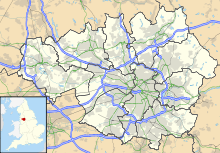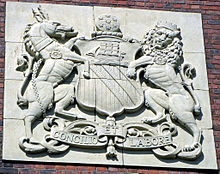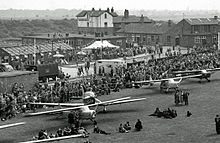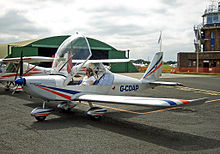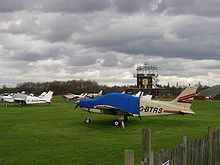- City Airport Manchester
-
For the major UK international airport, see Manchester Airport.
City Airport
Manchester/Barton Aerodrome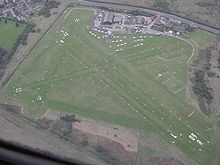
IATA: none – ICAO: EGCB Summary Airport type Public Owner Peel Group Operator City Airport Ltd Serves Manchester/Salford Location Barton-upon-Irwell, Eccles Elevation AMSL 73 ft / 22 m Coordinates 53°28′18″N 002°23′23″W / 53.47167°N 2.38972°WCoordinates: 53°28′18″N 002°23′23″W / 53.47167°N 2.38972°W Website Map Location in Greater Manchester Runways Direction Length Surface m ft 09R/27L 621 2,037 Grass 09L/27R 518 1,699 Grass 02/20 532 1,745 Grass 14/32 396 1,299 Grass Sources: UK AIP at NATS[1] City Airport (ICAO: EGCB) is a general aviation airport in the Barton-upon-Irwell area of Eccles, in the City of Salford, Greater Manchester, England. Formerly known as both Barton Aerodrome and City Airport Manchester. It is known by the UK Civil Aviation Authority as Manchester/Barton.
It is situated 5 NM (9.3 km; 5.8 mi) west of Manchester and was the United Kingdom's first purpose-built municipal airport. Featuring four grass runways, it is one of the busiest general aviation airports in the UK. The airfield operates seven days a week, from 9 am until sunset for fixed-wing aircraft. Commercial, military, police and air ambulance helicopters can operate during the hours of darkness by arrangement, as the airfield can be equipped with portable runway lighting.
The airport is also used as a refuelling stop for light aircraft and helicopters. However, it lies on the edge of Chat Moss and the aircraft movements area suffers from prolonged periods of waterlogging, restricting fixed wing operations at those times.
Manchester Barton Aerodrome has a CAA Ordinary Licence (Number P886) that allows flights for the public transport of passengers or for flying instruction as authorised by the licensee (City Airport Limited). The aerodrome is not licensed for night use.[2]
Contents
History
- Autumn 1928: Construction of Manchester's new municipal aerodrome at Barton, near Eccles started, to replace the temporary Manchester (Wythenshawe) Aerodrome.
- January 1930: The grass airfield and large hangar were completed. The first passenger charter flight occurred.[3] Barton was managed until 1933 by Northern Air Lines, who based several Avro 504s and other types for training, club and charter flights.
- Summer 1930: Imperial Airways operated a thrice-weekly scheduled service to London's Croydon Airport via Castle Bromwich Aerodrome, Birmingham, subsidised by the councils of Manchester, Liverpool and Birmingham. This service was timed to fly north from Croydon in the evening and to return south next morning, in order to provide connections to and from European airports from Croydon.[4]
- Spring 1933: A control tower and associated wireless station were completed,[5] the first at a municipal airport outside London, and able to communicate with aircraft in flight and give pilots bearings from the airfield. The tower is still operational and is believed to be the oldest in Europe still in use for its original purpose.
- August 1934: Scheduled services resumed. Croydon-based Railway Air Services commenced a Croydon-Barton-Belfast-Glasgow route.
- Spring 1935: Linking services to Liverpool, Blackpool and the Isle of Man were introduced.[6] Other smaller airlines, including Isle of Man Air Services operated services from Barton.
- June 1938: All schedules were transferred to the newly completed larger Ringway Airport[7] (which between 1940 and 1957 also accommodated RAF Ringway).
- World War II: Barton was requisitioned and used for military aircraft repair and overhaul, carried out by civilian firms including Air Taxis Ltd and David Rosenfield Ltd. Aircraft types involved were Avro Ansons, Dominies, Fairey Battles, Fairey Fulmars, Hawker Hurricanes and F4U Corsairs, followed by the scrapping of Fairey Swordfish. Over 700 Percival Proctor training and communications aircraft were assembled and tested at Barton by F. Hills & Sons of Trafford Park. There is a concrete air-raid bunker dating from this period hidden under overgrown vegetation near the main road (A57) still at the site.
- 1946: Lancashire Aero Club moved from Woodford Aerodrome to Barton[8] and remain based there until 2007.
- 1946 to 1953: Manchester University Air Squadron (MUAS) was based in one of the wartime-built western hangars. In 1953 the unit moved to RAF Woodvale near Southport, Lancashire. MUAS had flown Tiger Moth and Chipmunk trainers.
- 1 October 1948 to 31 March 1953: No.2 Reserve Flying School, also flying Tiger Moths and Chipmunks, was based at Barton and gave primary flight training to volunteers, who would later serve in the Royal Air Force. The unit used the same facilities as MUAS. On 31 March 1953 the unit closed.
- 21 July 1996 : The last known airworthy de Havilland Mosquito, a Trainer Mk III built by de Havilland at Leavesden in Spring 1945 (serial number RR299), crashed with the loss of both crew after suffering engine power loss when performing a wing-over manoeuvre during the Barton Aerodrome air show.[9]
- 2003: Manchester Ship Canal Developments, (of which Peel Holdings Group is the majority shareholder), bought the land, hangars and other buildings from Manchester City Council. The airport is now run by a subsidiary of Peel Airports, City Airport Ltd.
- 2006: The control tower underwent a major programme of rebuilding and refurbishment.
- 2007: Peel Holdings ordered Lancashire Aero Club to leave Barton.
City Airport has changed little since its opening, and is considered a good example of the airfields of the 1930s. There are several historical items of note at Barton; a small museum in the visitor centre displays documents from the history of the original Manchester Airport. The Bomber Command Association also has a display at the Barton Visitor Centre. The control tower is protected by its grade II listed building status, along with the original terminal building and hangar.
The airfield has been used as a setting for films and TV programmes, amongst them "Brass" (where Barton masqueraded as Croydon Airport), Mersey Beat, GBH and Island at War. The distinctive control tower featured prominently in the making of those programmes and films. [10]
Use of Barton Airport by heavier aircraft is hampered by the soft peaty nature of the area, being located at the edge of Chat Moss, and would have needed much heavy work consolidating the ground (compare the struggle building the Liverpool and Manchester Railway across Chat Moss in 1826); also by the low-lying land and areas of nearby standing water encouraging fog.
Emergency services air support
Both the Greater Manchester Police Air Support Unit and the North West Air Ambulance base a helicopter at the airfield. The Police Air Support Unit is active 24 hours a day, 365 days a year.
North West Air Ambulance is a registered charity providing a regional medical air emergency service covering Lancashire, Greater Manchester, Cheshire, Merseyside and Cumbria. The NWAA has one EC135 helicopter based primarily to serve Greater Manchester, South Lancashire, Cheshire and Merseyside.
Helicopter out of hours movements
City Airport can operate as an unlicenced airfield during the hours of darkness by arrangement for commercial, military, police and air ambulance helicopters, as the airport can be equipped with portable runway lighting. This facility is used particularly during football matches at nearby Old Trafford, (Manchester United) and City of Manchester Stadium (Manchester City).
Rescue and fire fighting
City Airport operates a Category 1 Rescue and Fire Fighting service with a Toyota Hilux Double Cab as a fire tender equipped with 80 imp gal (360 L; 96 US gal) of foam/water mix.
References
- Notes
- ^ Manchester/Barton - EGCB
- ^ Civil Aviation Authority Aerodrome Ordinary Licences
- ^ Scholefield pp. 222–223
- ^ Scholefield pp. 220–224
- ^ Scholefield p.224
- ^ Stroud p.38
- ^ Scholefield p.226
- ^ Maher p.41
- ^ "Air show fears after plane crash horror". Leigh Journal. 1996-07-22. http://archive.leighjournal.co.uk/1996/7/22/848513.html. Retrieved 2009-12-30.
- ^ Neal Keeling (23 May 2003). "Barton Airport gets makes the grade". Manchester Evening News. http://www.manchestereveningnews.co.uk/news/s/59/59219_barton_airport_gets_makes_the_grade.html. Retrieved on 28 August 2008.
- Bibliography
- Scholefield, R.A. (2004), "Manchester's early airfields: establishment, development and operations", an extensive article in "Moving Manchester", Lancashire & Cheshire Antiquarian Society, ISSN 0950-4699
- Stroud, John (1987), Railway Air Services, Ian Allan Ltd, ISBN 0-7110-1743-3
- Maher, Peter (1992), The Lancashire Aero Club : Three Score Years and Ten, Lancashire Aero Club, ISBN 0-9524099-0-9
External links
Categories:- Airports in England
- Airports established in 1930
- Buildings and structures in Salford
- Peel Airports
- Transport in Greater Manchester
- Grade II listed buildings in Greater Manchester
Wikimedia Foundation. 2010.

